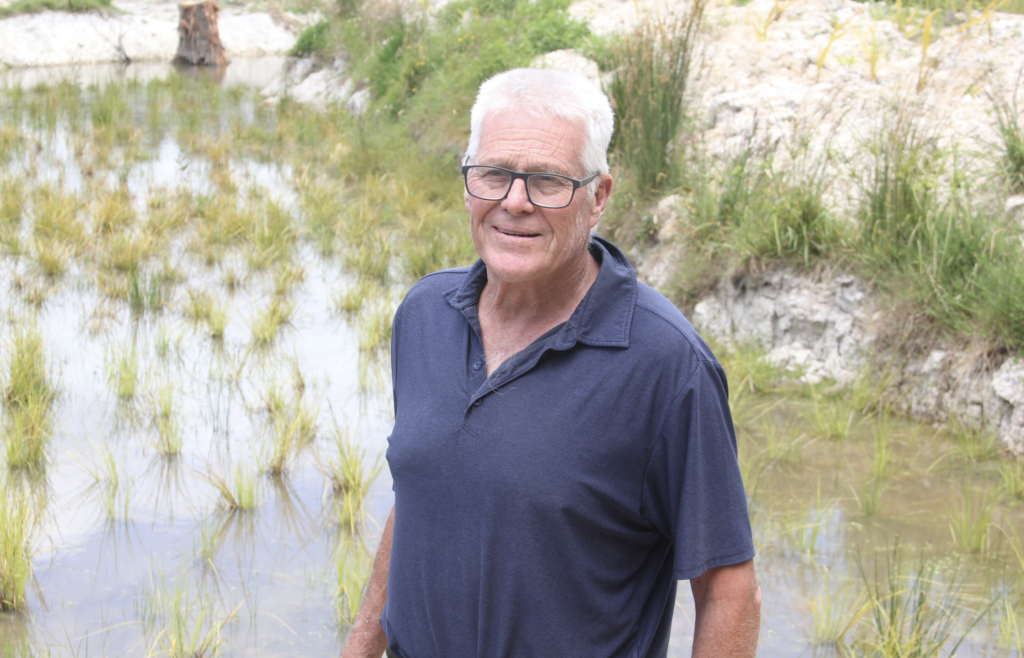Effective and reasonably priced constructed wetlands can do a great deal to reduce sedimentary run-off and provide a habitat for native species, a wetland demonstration day in Northland was told.
Held on the Matthews family beef farm south of Waipu in the northern foothills of the Brynderwyn range, the demonstration day attracted 35 local dairy and drystock farmers and landowners.
They heard from the farm owner, catchment co-ordinator Graham Matthews, as well as the Bream Bay Community Catchment Project, DairyNZ, Fonterra and Whitebait Connection.
Bream Bay Catchment Groups come under the umbrella of Piroa Conservation Trust, operating over 23,500 hectares of the Brynderwyns district of lower Northland.
The trust was founded on kiwi conservation and pest control and has broadened into catchment and landcare activities with about 30 groups.
With the help of Whitebait Connection and NZ Landcare Trust, several inanga spawning sites have been identified and efforts made to protect and enhance them.
Whitebait Connection spawning habitat restoration manager Nick Naysmith said inanga spend half of their lives in freshwater and constructed wetlands provide an ideal habitat for adult rearing sites.
The riparian needs include deep thick grasses to protect against sunlight and keep eggs wet enough not to dry out and fail.
Inanga are poor climbers. They like lowland habitats and require fish ladders to overcome perched culverts and steep rises.
The health of whitebait stocks feeds directly into the conservation of rare native birds, like the fairy terns (tara iti), a critically endangered species found only in the Waipu estuary and nearby Mangawhai heads.

Farmer Matthews was inspired by the inanga story and decided to have a small wetland built last winter in a low-lying area.
He told the field day that moving earth and constructing ponds and channels ideally should not be done in winter, but that was the only time available for local contractor Paul Jenkins.
About 4ha of catchment areas feed into the wetland site of about 800 sq metres. It contains about 30% sediment pond and 70% planted areas for nitrogen mitigation.
There is also a bypass for heavy flows during storms once the wetland vegetation is fully established.
“I have drawn on NIWA and DairyNZ publications, not following them 100% but making sure we have effective elements to get the maximum benefits from the least cost,” he said.
“Any of these features you incorporate into a wetland, well and good, and the more you do the better.”
NZ Landcare Trust co-ordinator in Hawke’s Bay Nathan Burkepile, formerly of Northland, is a specialist in wetlands restoration and construction and he has advised on the Matthews project.
The most important aspect is the sediment trap, which catches a surprising amount, Burkepile said.
A delay in construction was caused by the non-availability of a digger with laser height monitoring to ensure the right falls in the ponds and races.
Matthews is very conscious of water levels because the four varieties of sedges planted could be drowned under excess water.
He is increasing the water height by about 25mm a month.
The sedges in shallow water grow strongly and will shed leaves into rotting litter where bacteria perform the denitrification.
The excavated clay soils have been mounded and planted in natives and some big stumps left in the ponds to provide some inanga habitats.
Matthews had an existing wetland draining about 20ha elsewhere on his property when he put his hand up to construct a new one, follow best practice and open up the process to scrutiny on behalf of the Piroa Trust.
The whole project has cost Matthews about $7000 so far, half for construction and half for plants.
Simon Couper, a dairy farmer by the Millbrook River and trustee for Piroa Conservation Trust, has felt for some time there was a need to start a catchment group on the river.
“It’s a way to bring awareness of the river health and the collective responsibility for making waterways better.”










